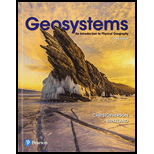
To describe:
The ways by which shifts in subtropical highs and subpolar lows affect the specific climatic patterns of midlatitudes.
Explanation of Solution
Introduction:
In subtropical areas, the rate of evaporation is high; due to which the amount of salinity increases. It is because evaporation leads to loss of water leaving the dissolved salts behind, further increases the salinity of the water body.
The subpolar low pressure possesses cyclones that are very low across north Atlantic and north Pacific. It results in a moist and cooler environment. The cool masses of air from the North and warm masses of air from the south collide and create front at the polar. In the cells of subtropical high pressure, occurrence of anticyclones takes place at the regions where air is forcefully pushed.
Want to see more full solutions like this?
Chapter 5 Solutions
Geosystems: An Introduction to Physical Geography (10th Edition)
- Test 3.1-Social Studies Name Records CHRISTIAN HIGH SCHOOL EQUIVALENCY EXAM All the questions are matching. Use the answers provided in each category to use in the blanks by each question. There is only one correct answer for each question. Please write only the letter by each answer to fill in the blank. Fill in each blank with a letter. You will have 60 minutes to complete this test for Social Studies U.S. Civics A. autocracy B. totalitarian C. papacy D. hierarchical E. anarchy F. lobby K. statute G. naturalization H. requisition L. adjudication M. bureaucracy N. gubernatorial O. referendum L. Tribunal J. invest The absence of a system of government and law. Having to do with a governor, of a governor. Presides over the House of Representatives. P. Speaker of the House Q. Vice President R. president-protempore S. committee chairman T. party whip The type of government in which one person holds supreme power. Assists party leaders. To give power, right or authority. Admitting a…arrow_forwardWhich oxidants oxidize NO to NO 2 (select all that apply)? 03 OH HO2 RO2arrow_forwardWhich oxidants must oxidize NO to NO 2 in order to lead to net formation of ozone (select all that apply)? ☐ 03 ☐ OH U HO2 RO2arrow_forward
- Exercise Ten / Geologic Time 177 d. Based on the ages of the rock layers in outcrop 1, identify an unconformity. Remember that an unconformity is a break in the rock record. Draw a wavy line on the figure to represent the unconformity. Ginkgo Period Ginkgo Lepidodendron Dimetrodon Period Tyrannosaurus Calamites Inoceramus Period Lepidodendron Rhodocrinites Archimedes Eurypterus Period Sharks Period Phacops Agnostus Outcrop 1 Period Period Ichthyosaurus Period Sharks Ceratites Period Paleolimulus A Figure 10.17 Sequences of sedimentary rock layers to accompany Question 7. 10.8 Numerical Dating with Radioactivity ■ Explain the principle of radiometric dating, including half-life, parent isotope, and daughter product. Radioactivity has provided a reliable means for calculating the numerical (absolute) age of rocks, a procedure called radiometric dating. Radioactive isotopes, such as uranium-238, emit particles from their nuclei that we call radiation. Ultimately, the process of decay…arrow_forwardDike K H Fault L Figure 10.12 Geologic block diagram of a hypothetical area. C Youngest B Intrusion J Oldest "arrow_forwardChrome File Edit View History 0 O ↑ X O SIS Ω 4-511 6 Bookmarks Profiles Tab Window Help X 4-510 X 4-509 + cl.castlelearning.com/Review/CLO/Student/Assignment/Questions?assignmentID=13205009&tid=9976762 0 Qad c 4-511 Select Language 98 Mon May 5 5:26 PM Relaunch to update CED Sal Salvatore Burgio 5009 Which cross section best represents the pattern of sediments deposited on the bottom of a lake as the velocity of the stream entering the lake steadily decreased? -Top 2. esc Bottom Top Bottom Top Bottom Top Bottom Submit Answer Zoom: Standard Note Bookmark Eliminator Highlighter Line Reader Reference Calculator Ruter Protractor MAY LO XA tv N Aa MacBook Pro C D Search or type URL ABGAB 1 2 # $ % & 3 4 5 6 7 8 00 Q W E R T Y U tab A S D F G caps lock shift H H ( 9 0 O + 11 Listen P [ ] J K L ? Z X C V B N M H command option L H fn control option command delete return shiftarrow_forward
- I need help with part b and c. I don't want an explanation I need the actual graph, because it's hard to understand an explanation without showing what they mean.arrow_forwardI need help with part b and c. I don't want an explanation I need the actual graph preferably broken down, because it's hard to understand an explanation without showing what they mean.arrow_forwardI need help with part b and c I don't know how to draw it.arrow_forward
 Applications and Investigations in Earth Science ...Earth ScienceISBN:9780134746241Author:Edward J. Tarbuck, Frederick K. Lutgens, Dennis G. TasaPublisher:PEARSON
Applications and Investigations in Earth Science ...Earth ScienceISBN:9780134746241Author:Edward J. Tarbuck, Frederick K. Lutgens, Dennis G. TasaPublisher:PEARSON Exercises for Weather & Climate (9th Edition)Earth ScienceISBN:9780134041360Author:Greg CarbonePublisher:PEARSON
Exercises for Weather & Climate (9th Edition)Earth ScienceISBN:9780134041360Author:Greg CarbonePublisher:PEARSON Environmental ScienceEarth ScienceISBN:9781260153125Author:William P Cunningham Prof., Mary Ann Cunningham ProfessorPublisher:McGraw-Hill Education
Environmental ScienceEarth ScienceISBN:9781260153125Author:William P Cunningham Prof., Mary Ann Cunningham ProfessorPublisher:McGraw-Hill Education Earth Science (15th Edition)Earth ScienceISBN:9780134543536Author:Edward J. Tarbuck, Frederick K. Lutgens, Dennis G. TasaPublisher:PEARSON
Earth Science (15th Edition)Earth ScienceISBN:9780134543536Author:Edward J. Tarbuck, Frederick K. Lutgens, Dennis G. TasaPublisher:PEARSON Environmental Science (MindTap Course List)Earth ScienceISBN:9781337569613Author:G. Tyler Miller, Scott SpoolmanPublisher:Cengage Learning
Environmental Science (MindTap Course List)Earth ScienceISBN:9781337569613Author:G. Tyler Miller, Scott SpoolmanPublisher:Cengage Learning Physical GeologyEarth ScienceISBN:9781259916823Author:Plummer, Charles C., CARLSON, Diane H., Hammersley, LisaPublisher:Mcgraw-hill Education,
Physical GeologyEarth ScienceISBN:9781259916823Author:Plummer, Charles C., CARLSON, Diane H., Hammersley, LisaPublisher:Mcgraw-hill Education,





